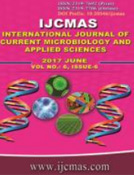


 National Academy of Agricultural Sciences (NAAS)
National Academy of Agricultural Sciences (NAAS)

|
PRINT ISSN : 2319-7692
Online ISSN : 2319-7706 Issues : 12 per year Publisher : Excellent Publishers Email : editorijcmas@gmail.com / submit@ijcmas.com Editor-in-chief: Dr.M.Prakash Index Copernicus ICV 2018: 95.39 NAAS RATING 2020: 5.38 |
75% of the mortality associated with burn injuries is related to infection The aim of the present study was to identify the bacterial profile of burn wound infection (BWI) in our setting and determine their susceptibility pattern to commonly used antibiotics.This prospective study was conducted over a period of one year in a teaching tertiary care hospital, Chennai. A total of 100 patients with burns of total body surface area (TBSA) of 20% to 40% were included. Three wound swabs on 1st, 4th and 7th day were collected aseptically and processed. Among the 274 samples collected, 191 swabs revealed growth while 83 showed no growth. Overall isolation rate was found to be 69.7% and was predominantly monomicrobial with Gram positive cocci in early swabs. Subsequent swabs showed 100% colonization with a shift to polymicrobial infection with predominant isolation of Gram negative bacilli. The most common isolate was Pseudomonas aeruginosa (35.84%), followed by Klebsiella pneumoniae (27.30%) Acinetobacter spp. (20.13%), Staphylococcus aureus (8.87%), Escherichia coli (2.38%). Gram negative bacteria were found to be highly susceptible to Imipenem and Piperacillin /Tazobactum. Staphylococcus aureus was 100% sensitive to Linezolid. Knowledge about specific pattern of burn wound infection and their resistant profile not only enable us to plan empirical antibiotics to prevent imminent septic episodes but also reduce infection related mortality in burns patients.
 |
 |
 |
 |
 |